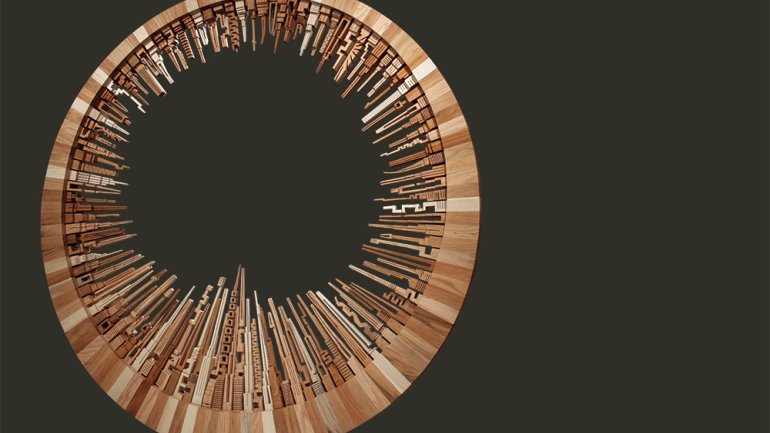Worlds Within Worlds
Worlds Within Worlds
BLAMMO. That’s the sound of popularity exploding for James McNabb’s City series.
Since the beginning of the year, when he submitted images to a single design blog, he’s been featured on dozens more, been commissioned by the New Yorker, and attracted hordes of loyal followers for his closely packed wooden assemblages of skyscrapers, office towers, high-rise apartments, and other edifices of the modern metropolis, all on a micro scale. As is true of any great city, there’s an energy born of sheer numbers and density – and there’s always something new to discover and look at. His frameworks vary: Some burst into space in a magnificent sphere, others rise majestically on a horizon; still others hang upside down from a table frame, a new perspective on our usual vertical, “look-up” urban environment.
It might seem only natural that a kid growing up in suburban New Jersey, a half-hour from Manhattan, would end up making images of the city. But it took him a while to get there. McNabb, 29, discovered woodworking in high school shop class, but hadn’t really considered art school until, one day online, he stumbled upon the woodworking program at the Rochester Institute of Technology. Once at RIT, he focused intensely on craft and design, and after graduating spent two years working as an administrative assistant at a vacuum pump company. He still lists it on his résumé – and he credits it for teaching him business skills he thinks every young artist should learn. He had stopped making, though, so in 2010 he took a leap of faith and went to grad school at Indiana University of Pennsylvania.
“It turned out to be a wonderful opportunity to revisit why I make things. At face value, I like making objects that I hope people think are fascinating to look at and intriguing enough to want to own,” but in the City series he found a more personal expression that he could build a body of work around.
“I’ve always been really ambitious, set big goals for myself, and the city really is a perfect place for me to do that. I always loved that highly competitive, fast-paced environment. The City series is a literal representation of those ambitions.”
The forms came first; one night in grad school, seeking relief from the intense logistics of designing, McNabb says, “I just grabbed a piece of scrap wood and fired up the bandsaw; I had no idea what it would be. I started cutting these shapes that were interesting. By the time I had about 15 or 20 of them in different heights and shapes and sizes, I lined them up on the bench and they started looking like a city skyline.” He stayed up all night cutting more, and by morning had almost 200.
Each piece is unique – he describes his process as “sketching on the bandsaw” – and they range from 4 to 18 inches high. The process dovetails with his artistic vision: a sense of freedom and adventure people find in a city, where “you can be whoever you want to be, do whatever you want to do.”
For the time being, he’s got his work cut out for him, literally and figuratively. Now living in Philadelphia, he’s busy filling orders for a successful Kickstarter campaign; backers could buy a single building for as little as $10; for modest increases, they got a “neighborhood,” or a “borough,” all the way up to a “metropolis.” (His elegant furniture work, which he had assumed would be his bread and butter, is on the back burner.) He’s working with a gallery in Miami that plans to ship his work to the Scope art shows in Basel, Switzerland. He’s got more ideas for the series, too, and he remains delighted that so many people have responded to his work so enthusiastically.
“It’s been kind of humbling,” he says. “I intentionally tried to find a balance with this work. I didn’t want to tailor it to art heads. Or to furniture makers. I wanted it to be very technically sound and very complex for people who like to make things who were eager to learn how it was made, but also interesting for people eager for the ‘back story’ behind the work, who could fill in the [conceptual] blanks.”
He’s happy that his work appeals to such a broad swath, defying easy categorization into “art” or “craft” (a debate he finds irrelevant and tiresome anyway). “For the moment, I’m perfectly fine living in that gray area. I’m going to continue to keep making it as long as I can – as long as people still want to see it.”
Judy Arginteanu is a writer and editor in Minneapolis, a recent Jeopardy! champion, and the copy editor for American Craft.

